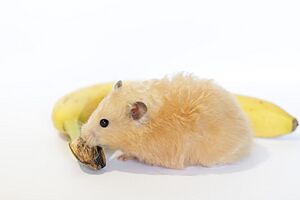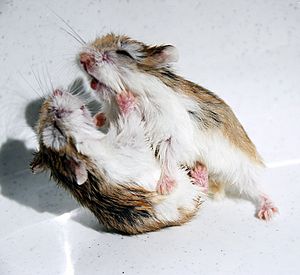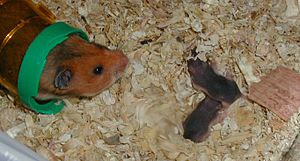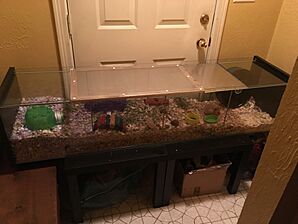Hamster facts for kids
Hamsters are small rodents that belong to the Cricetinae family. There are 19 different kinds, or species, of hamsters. They have become very popular small pets around the world.
The most well-known pet hamster is the Syrian hamster (Mesocricetus auratus), also called the golden hamster. Other popular pet hamsters include three types of dwarf hamsters: Campbell's dwarf hamster (Phodopus campbelli), the winter white dwarf hamster (Phodopus sungorus), and the Roborovski dwarf hamster (Phodopus roborovskii).
In the wild, hamsters are more active at dawn and dusk (crepuscular) than at night (nocturnal). They stay underground during the day to hide from animals that might hunt them. Wild hamsters mainly eat seeds, fruits, and plants. Sometimes, they also eat small insects. Hamsters have a strong body, a short tail, and furry feet. They have special, stretchy cheek pouches that go all the way to their shoulders. They use these pouches to carry lots of food back to their underground homes.
Contents
History of Hamsters
The Syrian hamster was first described by scientists in 1839. However, it wasn't until 1930 that a zoologist named Israel Aharoni captured a brother and sister hamster pair in Syria. These hamsters bred very well in Jerusalem.
All pet and laboratory Syrian hamsters today seem to come from this one pair! Later, some of these hamsters were sent to the United States. There, Syrian hamsters quickly became popular pets and animals for scientific study.
What's in a Name?
The word "hamster" comes from the German language. It's related to an old German word that might mean "to hoard." This makes sense because hamsters are famous for hoarding or storing food! In German, the verb hamstern means "to hoard."
Description of Hamsters
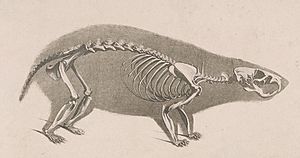
Hamsters usually have strong bodies and tails that are shorter than their bodies. They have small, furry ears, short legs, and wide feet. Their fur is thick and soft, and it can be long or short. Hamsters come in many colors like black, grey, honey, white, brown, yellow, red, or a mix of these.
Some hamsters, like Campbell's dwarf hamster, the Djungarian hamster, the Chinese striped hamster, and the Chinese hamster, have a dark stripe running from their head to their tail. The smallest hamsters are the Phodopus species, which are about 5.5 to 10.5 centimeters (2 to 4 inches) long. The largest is the European hamster, which can be up to 34 centimeters (13 inches) long, not including its short tail.
Most hamsters have very short tails, about one-sixth the length of their body. The Chinese hamster is an exception, as its tail is about the same length as its body. Hamsters have sharp incisors (front teeth) that grow all the time. They need to chew on things to keep their teeth from getting too long. Hamsters are very flexible, but their bones can be fragile. They are also sensitive to quick changes in temperature, so they need to be kept in a stable environment.
Hamster Senses
Hamsters don't have great eyesight. They are nearsighted and colorblind. This means they can't see far away or tell colors apart very well. However, their poor eyesight doesn't stop them from exploring! They can sense movement around them, which helps them stay safe from danger in the wild.
Hamsters have special scent glands on their sides (and on their bellies for Chinese and dwarf hamsters). They rub these glands on surfaces to leave a scent trail. This helps them mark their territory, find food, and tell the difference between male and female hamsters. Mother hamsters also use their sense of smell to find their own babies.
Hamsters have good hearing. They can learn to recognize sounds like their owner's voice or the sound of their food. They are also very sensitive to high-pitched noises and can even communicate using sounds that humans can't hear.
Hamster Diet
Hamsters are omnivores, which means they eat both plants and meat. In the wild, they eat seeds, grass, and even insects. Pet hamsters can eat special hamster food from the store. However, it's best to also give them fresh vegetables, fruits, seeds, and nuts to keep them healthy.
It's important to know which fruits and vegetables are safe. Hamsters do best with fruits that are not citrusy and most green leafy vegetables. Never feed hamsters junk food, chocolate, garlic, or any salty or sugary foods. Hamsters often love peanut butter, but be careful because it can get stuck in their cheeks. Wild hamsters in the Middle East have even been seen hunting insects together. Hamsters also eat their own poop sometimes (coprophagy) to get all the nutrients from their food.
Hamster Behavior
Feeding Habits
One famous hamster behavior is food hoarding. They use their large cheek pouches to carry lots of food back to their underground storage rooms. When their cheeks are full, their heads can look two or three times bigger! Hamsters in the wild lose weight in the fall to get ready for winter, even if they are pets and have plenty of food.
Social Behavior
Most hamsters prefer to live alone. If you put them together, they might get stressed and fight fiercely, sometimes even to the death. Some dwarf hamster species might get along with their brothers or sisters, or other hamsters of the same gender, if they are introduced when they are very young. But this is not always guaranteed. Hamsters communicate using their body language and by leaving scent trails. This helps them show how they are feeling to other hamsters and even to their owners.
Daily Rhythms
Hamsters are usually active at night (nocturnal) or during dawn and dusk (crepuscular). They spend most of the day underground, coming out about an hour before sunset and returning when it gets dark. This means they are mostly crepuscular.
Wild Syrian hamsters can hibernate during winter. This means their body temperature drops, and their body uses much less energy. This helps them save food during the cold months. Hibernation can last up to a week, but usually lasts 2-3 days. Pet Syrian hamsters usually do not hibernate.
Burrowing Behavior
All hamsters are excellent diggers. They build burrows (underground tunnels) with one or more entrances. These burrows have tunnels that lead to different rooms for sleeping, storing food, and other activities. They use their front and back legs, as well as their noses and teeth, to dig. In the wild, burrows protect them from extreme temperatures and from predators. Syrian hamsters dig their burrows about 70 centimeters (2.3 feet) deep. A burrow usually has a steep entrance, a nesting room, a food storage room, and a special branch for a toilet. Even pet hamsters love to dig if they have the right bedding!
Wild hamsters sometimes use tunnels made by other animals. For example, the Djungarian hamster might use paths and burrows made by pikas.
Hamster Life Cycle
Fertility and Breeding
Hamsters become ready to have babies at different ages, depending on their species. Syrian and Russian hamsters can start reproducing very young, at about 4-5 weeks old. Chinese hamsters usually start at two to three months, and Roborovskis at three to four months. Female hamsters can have babies for about 18 months, but male hamsters can breed for much longer.
Gestation and Litter Size
Syrian hamsters breed during certain seasons, usually from April to October in the Northern Hemisphere. They can have several litters (groups of babies) each year. After a pregnancy of 16 to 23 days, they can have 2 to 5 litters with 1 to 13 babies in each. Dwarf hamsters can breed all year round.
The pregnancy time for Syrian hamsters is 16 to 18 days. For Russian hamsters, it's 18 to 21 days. Chinese hamsters are pregnant for 21 to 23 days, and Roborovski hamsters for 23 to 30 days. A Syrian hamster litter usually has about seven babies, but can have as many as 24! Campbell's dwarf hamsters usually have 4 to 8 babies, but can have up to 13. Winter white, Chinese, and Roborovski hamsters tend to have slightly smaller litters.
Weaning Babies
Hamster babies are born without hair and are blind. They stay in a nest that their mother prepared. After about one week, they start to explore outside the nest. Hamsters can have new litters every month. Babies can be separated from their mother after three weeks old. At this age, they are considered mature. It's important to make sure they have food available as they stop relying on their mother's milk.
How Long Hamsters Live
Syrian hamsters usually live for about two to three years as pets, and even less in the wild. Russian hamsters (Campbell's and Djungarian) live about two to four years as pets. Chinese hamsters live about 2.5 to 3 years. The tiny Roborovski hamster often lives up to three years as a pet.
Hamsters in Society
Hamsters as Pets
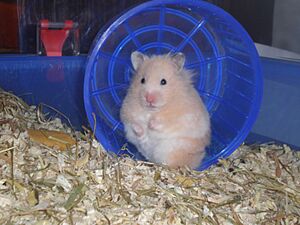
The Syrian hamster is the most common type of pet hamster. There are many different kinds of Syrian hamsters, including ones with long hair and various colors. Hamsters became popular pets in the United States as early as 1942.
Other popular pet hamsters are the three types of dwarf hamsters. Campbell's dwarf hamster is very common. The winter white dwarf hamster's fur can turn almost white in winter when there are fewer hours of daylight. The Roborovski dwarf hamster is extremely small and very fast, which can make it a bit harder to keep as a pet.
Hamster Shows
A hamster show is an event where people bring their hamsters to be judged. It's also a place for hamster lovers to share their excitement about these pets. Hamster shows help encourage careful breeding of hamsters that match certain standards.
Hamsters as Lab Animals
- Further information: Laboratory Syrian hamster
Scientists sometimes use hamster cells to study things like how cholesterol is made in the body.
Similar Animals
Some animals that are sometimes called "hamsters" are not actually part of the hamster family. For example, the maned hamster is actually a maned rat. Other similar animals include mouse-like hamsters and the white-tailed rat.
Images for kids
-
P. sungorus. The winter white dwarf hamster
-
P. roborovski. The Roborovski hamster
-
P. campbelli. The Campbell's dwarf hamster
See also
 In Spanish: Hámsteres para niños
In Spanish: Hámsteres para niños
- Hamster cage
- Hamster show
- Hamster wheel
- Hamster ball
- Chinchilla
- Ebichu
- Gerbil
- Guinea pig
- Hampster Dance
- Hamster racing
- Hamtaro
- Rat
- Wet-tail


